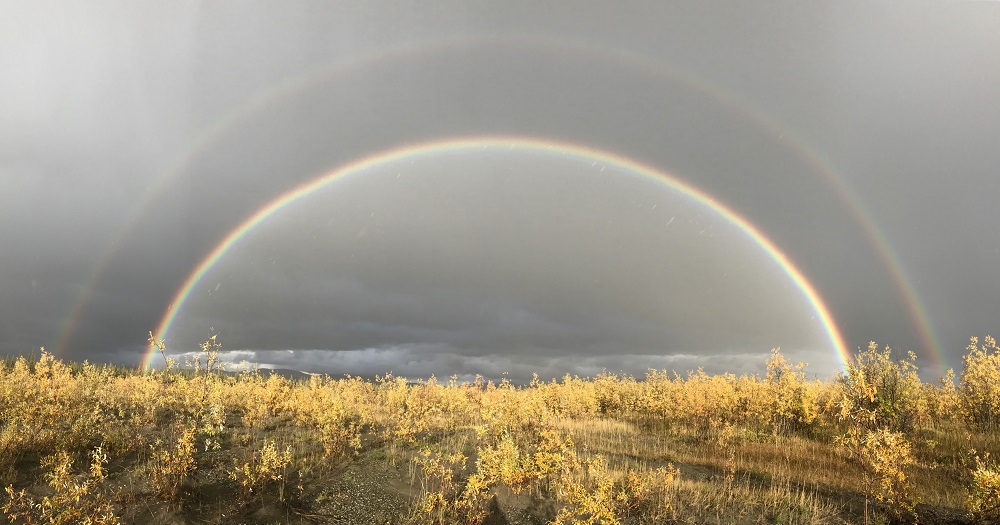Discovering The Soul Of The Arctic National Wildlife Refuge

A growing number of Alaskans are resolving to address climate change while also crafting a sustainable future for our state’s economy. Below, wilderness guide Haley Johnston describes what made her fall in love with the Arctic National Wildlife Refuge. And if you’re from Alaska and wish to add your voice, head on over here.
Above, a double rainbow on the Junjik River. (Haley Johnston)
Discovering the Soul of the Arctic National Wildlife Refuge
By: Haley Johnston
While renowned and beloved for its superlative qualities, I love the Arctic National Wildlife Refuge on a macro level. One evening I watched a small red-backed vole move her offspring, each no larger than a jelly bean, from one hiding spot to another. I was no less impressed by her adaptability and will to survive than by the caribou of the Porcupine Caribou Herd. And the first time I saw the delicate nodding bladder-campion growing amidst the raw bulldozed terrain of a glacier’s recent retreat, I was just as dazzled by this tiny flower, making a living in the most hostile environment, as I was by my first view of Mt. Isto’s glaciated slopes.
Silene uralensis, or nodding bladder-campion, growing in a glacial moraine. (Haley Johnston)
In 2012, I guided a rafting trip in the Arctic National Wildlife Refuge. It was my first trip to the Refuge and like most visitors, I was blown away by the mountains, the incredible hiking, the beautiful braided rivers and the general immensity of the place. The Refuge is what I came to Alaska to find: an expansive, pristine landscape, beautifully lonely, yet teeming with life.
Camped above the Marsh Fork of the Canning River. (Haley Johnston)
That first trip whet my appetite for long trips in the Arctic. Since then I have traveled to the Brooks Range for eleven trips, eight of which were in the Arctic Refuge. At times, I cannot believe my luck that I get to spend so much time in my favorite landscape, sometimes for work, sometimes on personal adventures.
Paddling the East Fork of the Chandalar River in late August. (Haley Johnston)
Still, after six years of traveling through the Arctic Refuge, I have barely scratched the surface. If I go back every year for the rest of my life, I will never see every valley, ridge or mountaintop of its 19 million acres. I will never walk every mile of caribou trail or scramble along every ridgeline. But to see it all is not my goal. Instead, I am building a catalog of incredible experiences and memories from my travels there, hoping to know the soul of the Refuge, if not every inch of its topography.
Traveling on ice highways and bridges in early June. (Haley Johnston)
The Refuge, when taken as a whole, is immense, even overwhelming. It is also an incredible, intact ecosystem – so rare and precious in modern times. To stand on a precipitous ridgeline and gaze out on braided rivers, limestone arêtes, rolling tundra and the coastal plain stretching all the way to the Beaufort Sea and know that there is not a single human development or road far beyond the limits of my vision means so much to me.
Hiking the tundra near the Kongakut River. (Haley Johnston)
That lack of development is also critically important to the animals who travel this land untroubled and unobstructed. To see a thousand caribou pour over a mountain pass and move over the tundra like so many droplets of water is awe-inspiring. But, knowing that these caribou calve on the much-debated lands of the Coastal Plain has moved me to do more than stand in awe.
The Refuge provides constant reminders of the caribous’ presence. (Haley Johnston)
I continue to feel compelled to visit the Arctic Refuge to seek out the intimate experiences that come with traveling at a backpacker’s pace, and I am proud to share the Refuge with guests who visit Alaska each year to see one of the last, great, wild places. But my experiences there have also moved me to speak out on the Refuge’s behalf. Having known this place intimately, sitting idly by and allowing exploitative industries to trammel this ecosystem is simply not an option.
Hikers near the Hulahula River amid the fall colors.(Haley Johnston)
Haley Johnston is a wilderness guide based in Anchorage, AK. She can be found taking tundra-naps and eating blueberries in some of Alaska’s wildest places.







